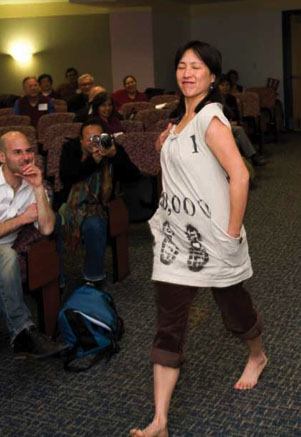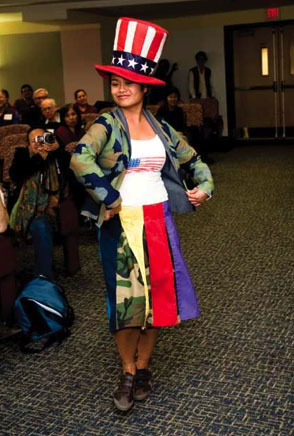fashion show postcard Set
Inspired by "The Runway Peace Project," Women of Color Resource Center, www.coloredgirls.org
 |
bikiniA French fashion designer used the name "bikini" for his two-pieces bathing suit after the US dropped an atomic bomb on Bikini Atoll in 1946. This dominated world headlines when his atom-sized bathing suit debuted on the runway. Women have been deployed to entertain US troops in bars and clubs for decades, many expected to wear a bikini--or something skimpier. Although the bikini is now part of mainstream fashion, the model chose to wear this bikini over her clothes. Photo: Ricky Chung. Model: Shinako Oyakawa. Bathing Suit: Old Navy. |
 |
military carbon footprintThe US Military is #1: the biggest emitter of greenhouse gas, the largest consumer of energy and fossil fuel, and the largest polluter in the world. The military uses 2 million gallons of oil a day for vehicles and facility maintenance alone. 50% of military energy consumption goes to fueling jet planes. The US military is the largest land user in the world with 1,000 bases worldwide and 70% of them in other countries. Photo: Ricky Chung. Model: Deborah Lee. Outfit: Annie Fukushima. |
 |
militarized federal budgetThe camouflage jacket represents 50% of the federal budget devoted to the military, $738 billion in 2009. The skirt shows the other 50%, earmarked for civilian needs: blue for health, red for energy, yellow for transportation etc. Underneath the military budget, the corporate flag indicates profits made by Pentagon contractors. More military money is tucked between the pleats: the VA in the health budget, Homeland Security in transportation, NASA and nuclear weapons research in the energy budget. Uncle Sam's hat hides billions of dollars financing the wars in Iraq and Afghanistan. Photo: Ricky Chung. Model: Ellen-Rae Cachola. Design: Christine Ahn and Sarah Shanley |
 |
People's budgetThis 3-piece cotton outfit remakes the military budget to meet people's needs. There are many pockets of money--for college, health care, renewable energy, good public transit, affordable homes, parks and gardens, filling in potholes, cleaning up trash, for drug treatment, AIDS research, community centers, care for everyone who needs care. There's money for poetry, music, theater, dance painting and everything you can imagine needed to live in peace and with justice. Photo Araceli Curiel. Model: Sandra Schwartz. Outfit: Gwyn Kirk.
|
 |
rosie the riveterThe US military deployed women like Rose Will Monroe who worked as a riveter on B-24 and B-29 bombers during World War II, when men went off to war. She starred in a promotional film used to convince women they had a patriotic duty to join the war effort on the "home front". "Rose the Riveter" has become a feminist icon with her bandana, rolled-up sleeves, and can-do attitude. When the war ended women were expected to return to their everyday housework as men returned from the war. Photo: Araceli Curiel. Model and Outfit: Sarah Block. |
 |
war brideUS anti-immigrant acts from Chinese Exclusion to the 1935 Filipino Repatration Act made it difficult for Asians to migrate to the US. However, the US military presence in the Asia-Pacific during World War II meant increased relations between US troops and local women. In 1945, Congress signed he War Brides Act. This somber bridal gown of fleece camouflage with its short black veil symbolizes the fate facing yung military brides -- that their soldier husbands may not return home. Photo: Araceli Curiel. Model: Hikaru Kasahara. Outfit: Jay Kim. |
 |
war is not sexyThis knee-length dress represents the military recruiters' subliminal message that war is sexy. The gold bracelets symbolize the promise of money for college, training for the future, and a large signing bonus. In reality, they are gold handcuffs. Once she joins, she's military property. The outfit's long black cape suggests the shadow of death that follows military operations. Don't let the military take your style! Death is not a fashion statement. Photo: Ricky Chung. Model: Genevie Gold. Outfit: AFSC Youth in Militarism Project. |